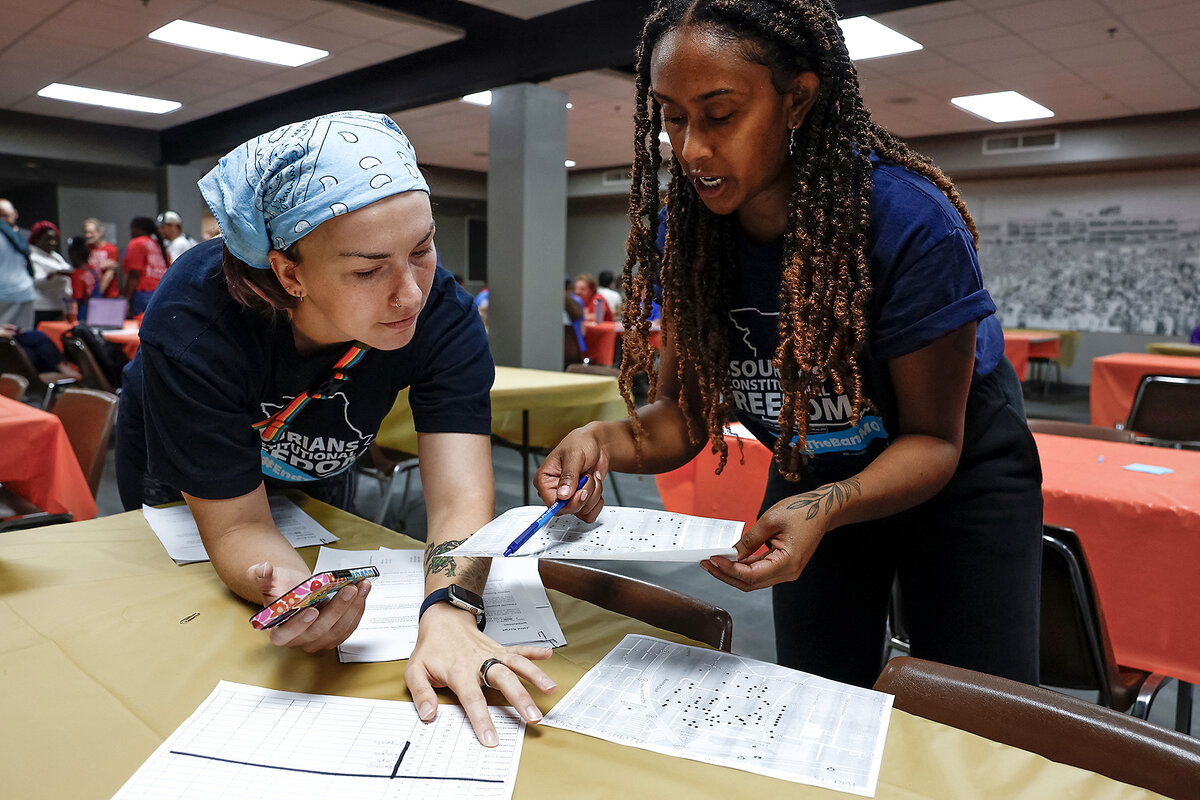The issue of immigration in the U.S. is tumultuous. But underneath the noise, a sea change has occurred that receives far less attention.

Why is Christian Science in our name?
Our name is about honesty. The Monitor is owned by The Christian Science Church, and we’ve always been transparent about that.
The Church publishes the Monitor because it sees good journalism as vital to progress in the world. Since 1908, we’ve aimed “to injure no man, but to bless all mankind,” as our founder, Mary Baker Eddy, put it.
Here, you’ll find award-winning journalism not driven by commercial influences – a news organization that takes seriously its mission to uplift the world by seeking solutions and finding reasons for credible hope.
Explore values journalism About usMonitor Daily Podcast
- Follow us:
- Apple Podcasts
- Spotify
- RSS Feed
- Download
 Mark Sappenfield
Mark Sappenfield
As people in the newsroom will tell you, I am a nuance fanatic. Put simply, if something isn’t nuanced, I generally don’t believe it. The desire for simplicity leads to the temptation to simplify. The results: polarization and bad policy.
So I love Whitney Eulich’s story today, for the same reasons I loved Francine Kiefer’s last week. We all must have the freedom to make up our own minds about a difficult issue like immigration. But essential to that is actually understanding the complex portrait of what is happening.
Help fund Monitor journalism for $11/ month
Already a subscriber? Login
Monitor journalism changes lives because we open that too-small box that most people think they live in. We believe news can and should expand a sense of identity and possibility beyond narrow conventional expectations.
Our work isn't possible without your support.
Today’s stories
And why we wrote them
( 6 min. read )
Today’s news briefs
• North Korea meeting with Russia: Russia’s top diplomat met his North Korean counterpart for talks amid reports that Pyongyang has sent thousands of troops to Russia to support its military in the war in Ukraine.
• Texas hospitals and immigration: Texas hospital patients will be asked if they’re in the United States legally starting Nov. 1.
• Fewer new jobs in October: U.S. employers added 12,000 jobs in October, a total that economists say was held down by the effects of strikes and hurricanes that left many workers temporarily off payrolls.
• Botswana ruling party defeated: Botswana’s president has conceded defeat in the general election. It is a seismic moment that ends the ruling party’s 58 years in power since the country’s independence from Britain in the 1960s.
• New York public schools honor Diwali: For the first time, New York City’s public school students have the day off to mark the holiday of Diwali, celebrated in India and among the global Indian diaspora as the victory of light over darkness.
( 6 min. read )
The U.S. Supreme Court overturned Roe v. Wade two years ago, passing the issue of abortion rights to the states – and their voters. Next week’s election will show us how states respond.
Podcast

‘A bridge to humanity’: Behind a Monitor series on an underreported story
Yes, the U.S. presidential election will be consequential. And yes, big powers and proxies are being drawn into high-profile conflicts. Our international news editor tells why and how we went deep on Sudan, too, where a civil war has been devastating, but where resilience and agency endure.
Why We Went Deep on Sudan
( 7 min. read )
The 2024 election may be the tipping point in which the digital culture determines what information is consumed and the public turns from the old reliable mainstream media to siloed, partisan news sources.
( 5 min. read )
Just as the Spanish women’s national team was celebrating its 2023 World Cup victory, it found itself embroiled in a fight with the soccer federation president over an unwanted kiss. Netflix has just released a documentary looking at the scandal.
The Monitor's View
( 2 min. read )
For America’s Election Day on Nov. 5, a pizza parlor plans to celebrate democracy. Valentina’s Pizzeria in Madison, Alabama, will offer pies and boxes with images of the two presidential candidates, hoping to encourage customers to talk with one another.
“It’s a tense race and pizza is the comfort food of America. It brings everybody together,” owner Joe Carlucci told a local TV station. “No matter who wins this race we have to stand behind them good, bad, or indifferent, we have to come together as a country.”
Also on Nov. 5, voters in Philadelphia heading to three polling stations will be invited to attend local festivals of art and music designed to depict the wonders of “the democratic process.” Voting day should “be a joyful celebration of our shared ability to shape the future,” said Lauren Cristella, head of a nonpartisan organization sponsoring the event.
In Traverse City, Michigan, meanwhile, residents attended a recent outdoor “celebration of democracy” that included a man dressed up as Uncle Sam. The festival served as a reminder of the resilience of the electoral system.
Such events don’t make much news, but they do act as community-based counterpoints to the national dread expressed during the election. Nearly 4 in 5 Americans report anxiety because of the campaign, according to a poll in August by LifeStance Health. About a third say the idea of discussing politics has deterred them from attending a social event.
Yet pro-democracy activists say that encouraging fun events around elections is essential.
“Those of us who work in community engagement can either fan sparks of delight or extinguish them,” wrote Wendy Willis of the National Civic League last year. “As we see ourselves as stewards of democracy and stewards of delight, we can do both at the same time without missing a beat.”
Around the world, people living in nondemocratic nations may be scratching their heads over the fact that so many Americans do not appreciate the strength of their democracy. That feeling is especially true during a super-cycle of elections. Nearly half of the world’s population is casting ballots in 2024, a record number. There is also a historic number of elections.
In countries that have recently restored or saved their democracies – from Senegal to Guatemala to Bangladesh – celebrating their triumphs comes naturally. One example is Moldova, which held a vote for president on Oct. 20 as well as a referendum on European Union membership.
“It was a celebration of democracy at the end of the day,” Mihai Popșoi, Moldovan deputy prime minister, told CNN. “Despite the Kremlin’s [vote-buying] assault on Moldovan democracy, our democracy has withstood, and it has shown the entire world what the will of the people is.”
In Washington, one celebration of democracy did take place, on Sept. 15, for International Day of Democracy. In a press statement, Antony Blinken, secretary of state, said, “We celebrate democracy as the single most powerful tool for unleashing human potential.”
That potentiality, presumably, includes building, protecting – and celebrating – democracy.
A Christian Science Perspective
Each weekday, the Monitor includes one clearly labeled religious article offering spiritual insight on contemporary issues, including the news. The publication – in its various forms – is produced for anyone who cares about the progress of the human endeavor around the world and seeks news reported with compassion, intelligence, and an essentially constructive lens. For many, that caring has religious roots. For many, it does not. The Monitor has always embraced both audiences. The Monitor is owned by a church – The First Church of Christ, Scientist, in Boston – whose founder was concerned with both the state of the world and the quality of available news.
( 3 min. read )
There’s an alternative to letting anger or resentment drive our lives: opening our hearts to God’s love, which redeems and heals.
Viewfinder

A look ahead
Thank you for coming along with us this week. As you might imagine, we have a trove of stories lined up for next week, including coverage of the U.S. presidential election – from swing states to vote counting. We’ll also look at the trajectory of Hezbollah, with evidence that faith in the organization is waning in some quarters.








